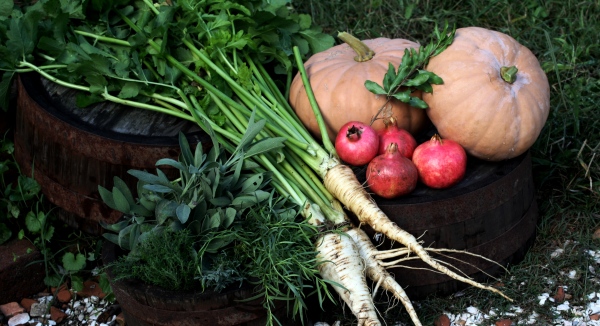
Fall is the season of flavors, including my personal favorite—pumpkin! But during my visit to the Colonial Garden, I learned that the pumpkins we enjoy so much in our Thanksgiving pies and Starbucks lattes are actually… squash.
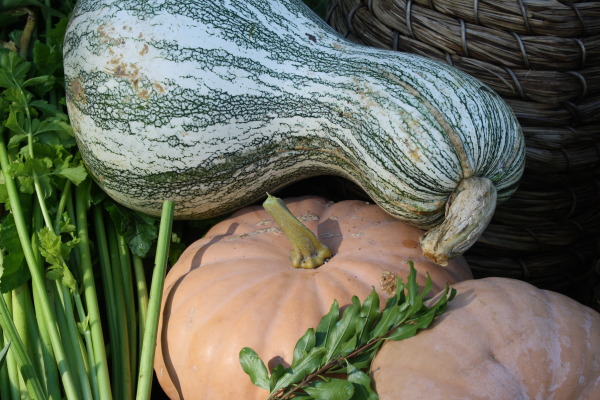
That’s right. This is a picture of the Cushaw squash and the Long Island Cheese Pumpkin, both grown in the 18th century. The difference is what’s on the inside. When you cut into the squash, you’ll find plenty of “flesh” to scoop out and cook with. It’s actually what modern farmers grow and sell—and what’s in most of the cans of pumpkin puree you buy at the grocery store.
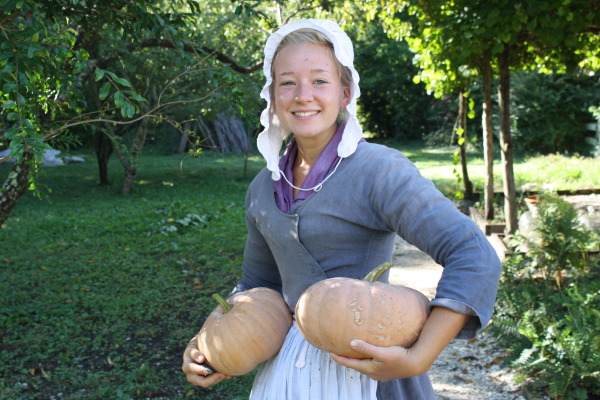 A true “pumpkin” is extremely hollow and stringy inside. That’s not to say you can’t eat it. These pumpkins are sweet and taste similar to butternut squash. And they actually get even sweeter as they age, even off the vine. During the 1700s, they weren’t used often in cooking unless it was for soups and stews. Occasionally, they would be roasted, gutted, then re-stuffed. But the most common use for pumpkins was to flavor beer and to feed livestock.
A true “pumpkin” is extremely hollow and stringy inside. That’s not to say you can’t eat it. These pumpkins are sweet and taste similar to butternut squash. And they actually get even sweeter as they age, even off the vine. During the 1700s, they weren’t used often in cooking unless it was for soups and stews. Occasionally, they would be roasted, gutted, then re-stuffed. But the most common use for pumpkins was to flavor beer and to feed livestock.
 Parsnips are an old world crop—brought here from England. It takes all season to grow these root vegetables. The ones we pulled for our blog were actually planted in our garden back in March. They won’t really sweeten up until after the first frost, likely in November. Jenny Mrva says they can stay in the ground all winter and be harvested as needed. It’s likely colonists stored them in damp sand in what they called root cellars, until they needed them. Just like pumpkins, you can add parsnips to soups and stews and in the 18th century, they would often get mixed with potatoes and placed under meat turning on a spit. The fat that dripped down would crisp up the outside of the veggies and add extra flavor.
Parsnips are an old world crop—brought here from England. It takes all season to grow these root vegetables. The ones we pulled for our blog were actually planted in our garden back in March. They won’t really sweeten up until after the first frost, likely in November. Jenny Mrva says they can stay in the ground all winter and be harvested as needed. It’s likely colonists stored them in damp sand in what they called root cellars, until they needed them. Just like pumpkins, you can add parsnips to soups and stews and in the 18th century, they would often get mixed with potatoes and placed under meat turning on a spit. The fat that dripped down would crisp up the outside of the veggies and add extra flavor.

Pomegranates are the most ancient of all culinary fruits and originated in Persia. In Colonial Virginia, they appeared on several dinner tables, but mostly to make a statement. Having the bright red fruit on display in the 18th century was a sign of wealth. In 1770, George Wythe gave his star pupil, Thomas Jefferson, a pomegranate tree as a gift. The fruit back then was extremely bitter. Originally from the Middle East, pomegranates need 100 degree dry heat to sweeten, which simply didn’t jive with Colonial Williamsburg’s climate.
Here are 18th-century recipes for the 21st-century kitchen. Check back tomorrow for our chef’s modern recipes inspired by these fresh colonial ingredients.
What’s your favorite way to eat pumpkins, parsnips, and pomegranates?
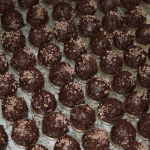
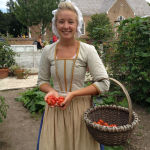

[…] Earlier this week, we told you that in the 18th century, pumpkins were mainly used to flavor beer an…. However, in the 21st century, we don’t like to simply carve our pumpkins in October, we like to eat (and drink) them! […]